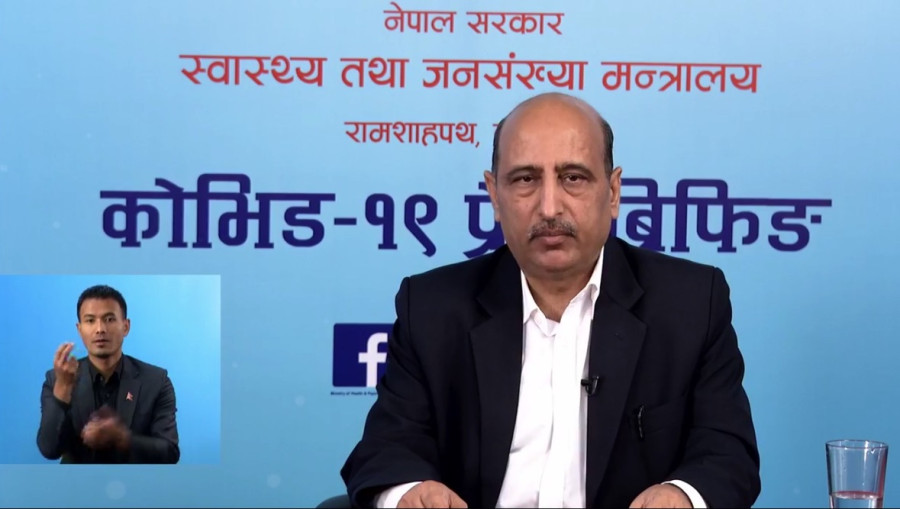Health
No risk communication strategy yet as Covid-19 infections and death toll soar
With no such strategy, and routine briefings limited to daily infection and death counts, authorities have done more harm than good, public health experts say.
Arjun Poudel
The Ministry of Health has stopped daily Covid-19 briefings starting Thursday, and adopted a biweekly reporting—on Sundays and Wednesdays.
Doctors within the ministry and those outside welcomed the decision, saying that the daily count of coronavirus infections and resulting deaths, along with advisories related to the pandemic had enraged people as the briefings carried nothing, reminding the general public of the government’s failure to contain the pandemic.
“In medicine, students are taught ‘to do no harm’,” a doctor at the Health Ministry told the Post. “People were infuriated at the way messages were given in the daily briefings, even if they were correct and scientific. We were actually doing more harm than good.”
Public health experts say that lack of public trust in the authorities is responsible for people not taking the health warnings seriously. And a lack of risk communication strategy is to blame for communication misfire in many instances, according to them.
Even after nine months since Nepal reported its first coronavirus case, the Health Ministry has yet to introduce a risk communication strategy.
“We have completed the drafting of both risk communication strategy and guidelines and forwarded them to the Health Ministry for review,” Dabal BC, an official at the Epidemiology and Disease Control Division, told the Post. “Both the strategy and the guidelines will come into effect once they’re endorsed by the Health Ministry.”
Health Ministry spokesperson Dr Jageshwor Gautam had urged the public to take the blessings of elderly people by phone, to wear old clothes, wear masks, maintain distance, visit the hospital only if patients have breathing difficulties or they feel like fainting, and not to leave their house unless it is necessary. He had also called on the people not to travel to their hometowns for Dashain.
Health experts say there was nothing wrong with the messages, as they were correct and scientific. But people took them in the negative light. That’s largely because the messages looked like a last resort after the government’s spectacular failure, according to them.
Had there been a proper risk communication strategy and people were continuously informed about the pandemic, things would have been different, said a doctor who in the past headed the Epidemiology and Disease Control Division.
The objective of risk communication is making people informed about risk factors, educating them, encouraging them not to panic and motivating them to change behaviour.
“Instead of making people informed about the risks by giving them right information, the authorities created panic,” Dr GD Thakur, former director at the Epidemiology and Disease Control Division, told the Post.
“At a time when the authorities were supposed to work sincerely to curb infections, they kept on enforcing restrictions. People are not taking the warnings and suggestions seriously.”
In the initial stage of the pandemic, authorities tested the infected people more than a dozen times and now they have stopped testing. All infected people were taken to hospital isolation in the beginning, but now thousands of patients are left at home and authorities are not even asking about their health conditions.
Of the 38,952 active cases on Thursday, around 30,000 are in home isolation. And no one is inquiring about their health conditions, officials admit.
“People started panicking in the initial stage when there was little or no risk,” said Dr Radhika Thapaliya, a risk communication expert. “Now there is more risk, but people are not taking the risks seriously. This all happened due to the failure to communicate properly.”
A risk communication strategy necessarily entails communication based on trust between experts, authorities and the people who are affected.
According to the World Health Organisation, risk communication strategies include real-time exchange of information, advice and opinions between experts or officials and people who face the threat to their survival, health or economic and social well-being. Through such strategies, everyone at risk is able to make informed decisions to mitigate the effects of the threat and take protective and preventive measures, says the UN health agency.
Effective risk communication strategy is one of the reasons behind successfully containing the virus in Singapore, Taiwan, Japan and Pakistan. Pakistan has been able to contain the virus spread without imposing a lockdown but by enforcing measures to deter crowds in public spaces.
As of Thursday, 164,718 have people tested positive for Covid-19 nationwide with 904 deaths. In the last 24 hours 2,364 people tested positive for the virus including 1,615 in Kathmandu Valley.
According to Dr Sher Bahadur Pun, chief of the Clinical Research Unit at Sukraraj Tropical and Infectious Disease Hospital, gaining public trust is crucial in fighting the pandemic.
“Not organising daily press briefings will not make a big difference,” Pun told the Post. “What really makes a difference is how we communicate the risk, and how people perceive it.”




 5.39°C Kathmandu
5.39°C Kathmandu













%20(1).jpg&w=300&height=200)
